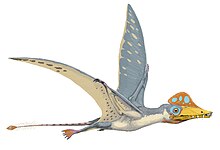Scaphognathus
| Scaphognathus Temporal range: Late Jurassic,
| |
|---|---|

| |
| Holotype specimen | |
| Scientific classification | |
| Domain: | Eukaryota |
| Kingdom: | Animalia |
| Phylum: | Chordata |
| Order: | †Pterosauria |
| Family: | †Rhamphorhynchidae |
| Subfamily: | †Scaphognathinae |
| Genus: | †Scaphognathus Wagner, 1861 |
| Type species | |
| †Pterodactylus crassirostris Goldfuss, 1831
| |
| Species | |
| |
| Synonyms | |
| |
Scaphognathus was a pterosaur that lived around Germany during the Late Jurassic. It had a wingspan of 0.9 m (3 ft).
Description

At present Scaphognathus is known from three specimens, all of which originated in the Kimmeridgian-age[1] Solnhofen Limestone.[2] Physically it was very similar to Rhamphorhynchus, albeit with notable cranial differences.[2]
For one, Scaphognathus had a proportionately shorter skull (4.5 in) with a blunter tip and a larger antorbital fenestra.[2] Its teeth oriented vertically rather than horizontally. The traditional count of them held that eighteen teeth were in the upper jaws and ten in the lower.[2] S. Christopher Bennett, studying a new third specimen, SMNS 59395, in 2004 determined there were only sixteen teeth in the upper jaws, the higher previous number having been caused by incorrectly adding replacement teeth.[3]
Comparisons between the scleral rings of Scaphognathus and modern birds and reptiles suggest that it may have been diurnal. This may also indicate niche partitioning with contemporary pterosaurs inferred to be nocturnal, such as Ctenochasma and Rhamphorhynchus.[4]
Naming

The first known Scaphognathus specimen was described in 1831 by August Goldfuss[5] who mistook the tailless specimen for a new Pterodactylus species: P. crassirostris.[2] The specific name means "fat snout" in Latin. This specimen was an incomplete adult with a 0.9 m (3 ft) wingspan recovered from the Solnhofen strata near Eichstätt. In 1858 Johann Wagner referred the species to Rhamphorhynchus. After recognising the fundamentally different snout shape, Wagner, after previous failed attempts by Leopold Fitzinger and Christoph Gottfried Andreas Giebel, who used preoccupied names, in 1861 named a distinct genus: Scaphognathus, derived from Greek skaphe, "boat" or "tub", and gnathos, "jaw", in reference to the blunt shape of the lower jaws.[6]
In the early twentieth century, the "rhamphorhynchoid" nature of S. crassirostris was recognized after the discovery of the second specimen in Mühlheim, whose long tail was preserved. The second Scaphognathus specimen was more complete than its predecessor, but only half the size (twenty inch wingspan) and with partially ossified bones.[2] These characters indicate that the second specimen was a juvenile.[2]
Classification

The cladogram (family tree) of rhamphorhynchids below is the result of a large phylogenetic analysis published by Andres & Myers in 2013.[7]
| Breviquartossa |
| ||||||||||||
See also
References
- ^ Weishampel, David B; et al. (2004). "Dinosaur distribution (Late Jurassic, Europe)." In: Weishampel, David B.; Dodson, Peter; and Osmólska, Halszka (eds.): The Dinosauria, 2nd, Berkeley: University of California Press. Pp. 545–549. ISBN 0-520-24209-2.
- ^ a b c d e f g "Scaphognathus." In: Cranfield, Ingrid (ed.). The Illustrated Directory of Dinosaurs and Other Prehistoric Creatures. London: Salamander Books, Ltd. Pp. 308-309.
- ^ Bennett, S. C. (2004). "New information on the pterosaur Scaphognathus crassirostris and the pterosaurian cervical series", Journal of Vertebrate Paleontology, 24(Supplement to #3):38A
- ^ Schmitz, L.; Motani, R. (2011). "Nocturnality in Dinosaurs Inferred from Scleral Ring and Orbit Morphology". Science. 332 (6030): 705–8. doi:10.1126/science.1200043. PMID 21493820.
{{cite journal}}: CS1 maint: multiple names: authors list (link) - ^ Goldfuss G. A. (1830). "Pterodactylus crassirostris". Isis von Oken, Jena pp. 552–553
- ^ Wagner, J.A. (1861). "Uebersicht über die fossilen Reptilien des lithographischen Schiefers in Bayern nach ihren Gattungen und Arten". Sitzungsberichte der königlich bayerischen Akademie der Wissenschaften zu München, 1861 Theil 1: 497–535.
- ^ Andres, Brian; Myers, Timothy S. (2013). "Lone Star Pterosaurs". Earth and Environmental Science Transactions of the Royal Society of Edinburgh. 103 (3–4): 383. doi:10.1017/S1755691013000303.
Literature
- Fantastic Facts About Dinosaurs (ISBN 0-7525-3166-2)
